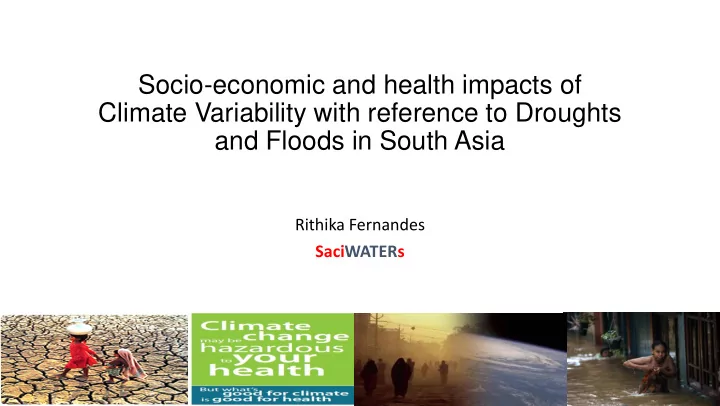

Socio-economic and health impacts of Climate Variability with reference to Droughts and Floods in South Asia Rithika Fernandes SaciWATERs
Introduction Increase in frequency of extreme climatic events which can be classified into two types: • Extremes based on simple climatic measures eg: very high or low temps • More complex, even driven extremes eg: droughts, floods, cyclones • Climate extremes can have devastating effects on human societies. • Human history is coloured with famines, population displacements, disease outbreaks etc. post droughts and floods • Worst effect is on poor countries. • Higher temperatures, more variable precipitation, more extreme weather events and sea level rise, will intensify in South Asia, as will it all over the world.
• These changes are already having major impacts on the economic performance of South Asian countries and on the lives and livelihoods of millions of poor people. Future impacts of climate change for the South Asian region as detailed by the Intergovernmental Panel on Climate Change fourth Assessment report are • Glacier melting in the Himalayas is projected to increase flooding and will affect water resources within the next two to three decades. • Climate change will compound the pressures on natural resources and the environment due to rapid urbanization, industrialization, and economic development. • Crop yields could decrease up to 30% in South Asia by the mid ‐ 21st century. • Mortality due to diarrhea primarily associated with floods and droughts will rise in South Asia. • Sea ‐ level rise will exacerbate inundation, storm surge, erosion and other coastal hazards.
What does that mean for the region’s inhabitants? The consequences of such environmental changes include: • decreased water availability and water quality in many arid and semiarid regions • an increased risk of floods and droughts in many regions • reduction in water regulation in mountain habitats • decreases in reliability of hydropower and biomass production • increased incidence of waterborne diseases such as malaria, dengue, and cholera • increased damages and deaths caused by extreme weather events • decreased agricultural productivity • adverse impacts on fisheries • adverse effects on many ecological systems
• Strong linkages are established between poverty, high social vulnerability to low capacity to cope with water related hazards and disasters (UNESCO 2006) • Areas with lowest socio ‐ economic conditions show higher mortality rates • This underlines the need to examine the impact of ENSO type events in order to devise for adaptive management strategies
Socio-economic impacts of Droughts Social impact of droughts is many fold: • Starvation, mortality, health issues • Migration which results in break down of family structure • Political impact Economic impact: • impact on economic growth and development • Agriculture and livestock
Socio- economic impact of Floods • Loss of Lives and property • Impact on livelihoods • Impact on economic growth and development • Psychological morbidity • Political impacts • Health impacts
ENSO events and health Paucity of information
http://dewita.wordpress.com/2010/10/11/food ‐ and ‐ health ‐ related ‐ costs ‐ of ‐ climate ‐ change/
• A growing number of studies have shown that the El Niño cycle is associated with changes in the risk of diseases transmitted by mosquitoes, such as malaria and dengue and other arboviruses. • An interaction of appropriate social, economic and ecological/biological factors during drought and flood events could result in disease outbreaks • A vulnerability map that takes into account these factors during climate variability events, could be a useful tool to develop mitigation and adaptation strategies to reduce the impacts of such events
Recommend
More recommend